Unit 6 of Pathway to Fluency is here, and it’s filled with effective and fun activities to teach reading! I released Unit 6 a few weeks ago, but I’m only just getting around to writing the blog post because there is SO MUCH packed into it!
Unit 6 continues the systematic approach of reading instruction. In Unit 6 of Pathway to Fluency, students will learn how to decode and encode words that have the following phonics skills: inflectional endings, 2-syllable words with a closed/closed syllable pattern and an open/closed syllable pattern, y as a vowel, consonant + le endings, and silent letters. As I mentioned, this is a LOT to pack in, so take a look!
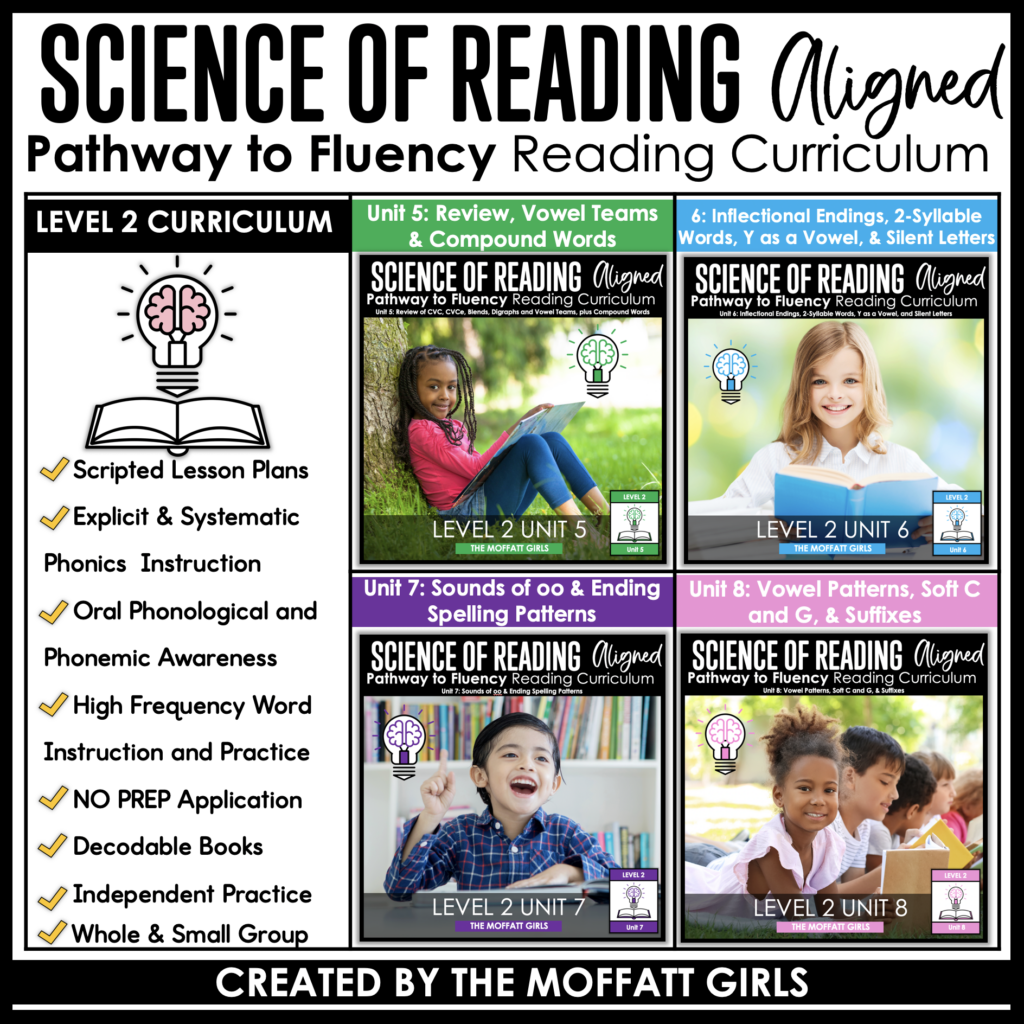
If you are unfamiliar with this reading program, I’ll break it down for you. Pathway to Fluency is a complete and comprehensive Science of Reading (SoR) Aligned Curriculum! Simply stated, it has everything you need for your whole-group, small-group and one-on-one reading instruction. Furthermore, Pathway to Fluency has been developed to teach everything from phonological awareness to fluency and spelling in a systematic way using methods that have been proven to be effective.
In the blog post for Pathway to Fluency Unit 1, I offered an explanation of what Science of Reading is and why it is vitally important when teaching children how to read. The Unit 1 blog post also includes an outline of the scope and sequence of Level 1 of the Pathway to Fluency Curriculum.
To read the Unit 1 blog post, Click Here. For the blog post for Unit 2, Click Here. To see Unit 3 in action, Click Here. To read the blog post for Unit 4, Click Here. For the Unit 5 blog post, Click Here.
Scope and Sequence for Level 2 of Pathway to Fluency
Here’s an outline of the scope and sequence for Level 2 of the Pathway to Fluency Curriculum.
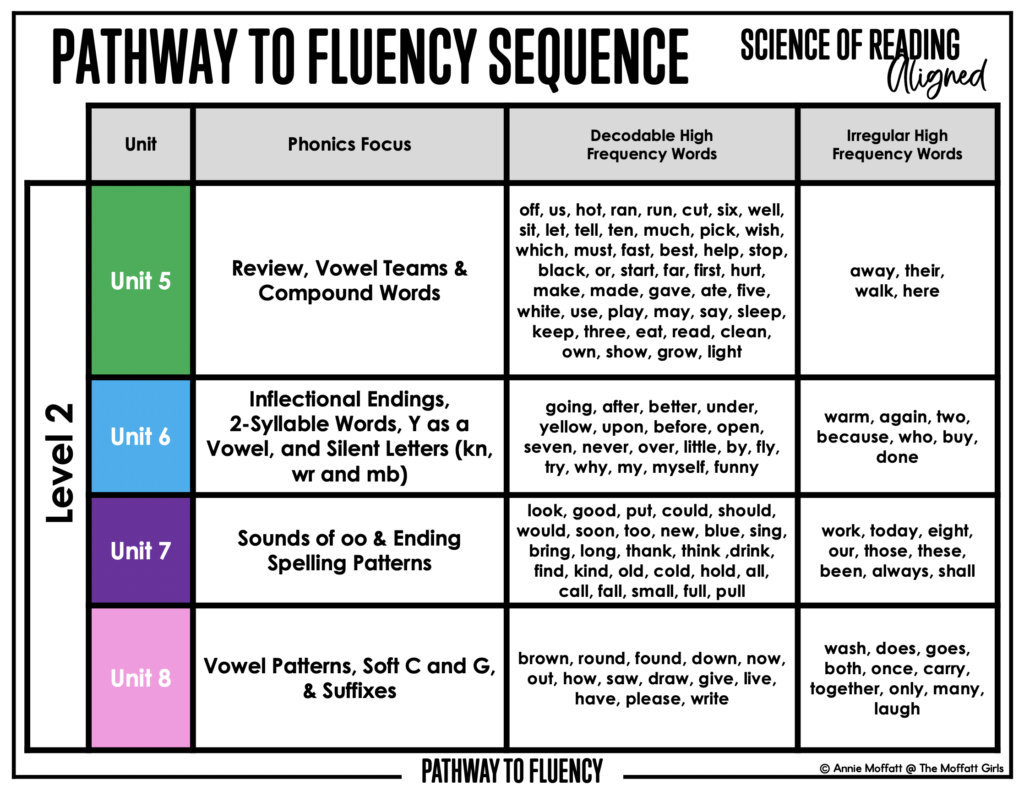
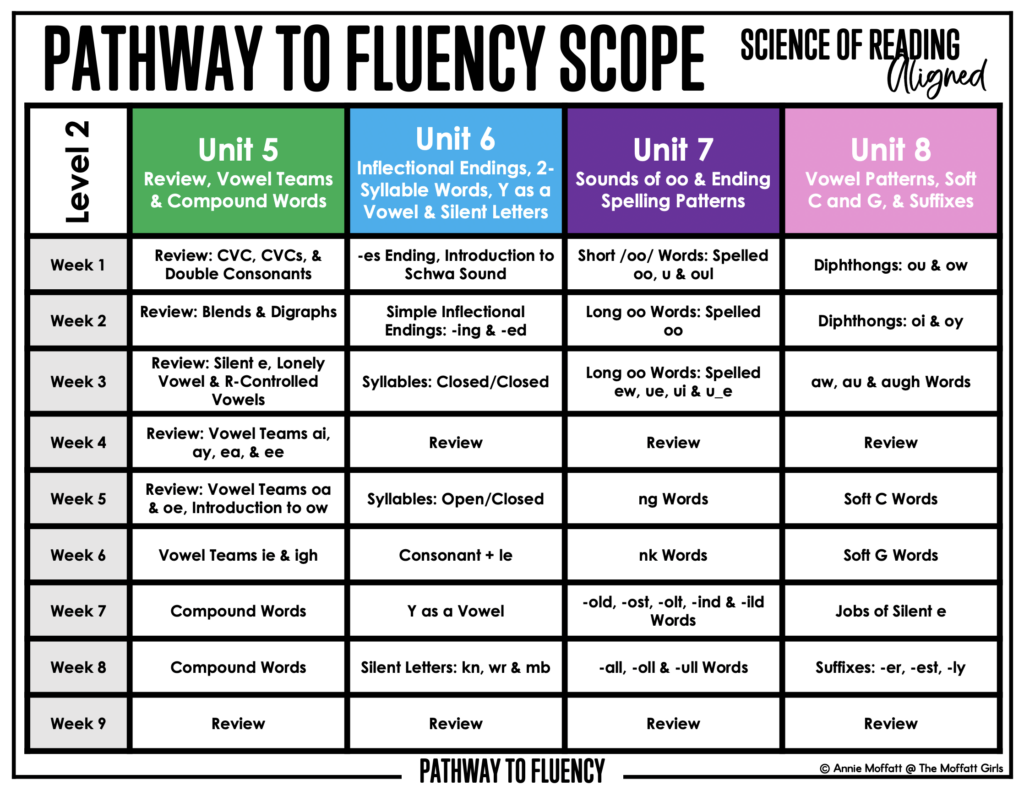

WHAT’S INCLUDED IN PATHWAY TO FLUENCY UNIT 6?
Pathway to Fluency has everything you need for your whole-group, small-group and one-on-one reading instruction. It has been developed to teach everything from phonological awareness to fluency and spelling in a systematic way using methods that are proven to be effective.
START HERE FILE
I have included the Start Here file to give you an introduction to Pathway to Fluency Unit 6. It also provides a brief overview of what the term science of reading means and how to implement best practices in your classroom using the Pathway to Fluency Curriculum. I encourage you to refer to this file as you teach through Unit 6 for helpful reminders.

FOLDER #1: LESSON PLANS AND ASSESSMENTS
Unit 6 includes 9 weeks of instruction with lesson plans for whole group lessons and small group center practice. These easy-to-follow lesson plans provide a structured approach to help you introduce, practice and apply the Pathway to Fluency materials and concepts in your classroom. More specifically, each lesson is broken down into 4 categories: Oral Phonological & Phonemic Awareness, Phonics, High Frequency Words, and Application & Independent Practice. The first three categories are done in a whole-group setting, while the Application & Independent Practice is done in small-group centers.


Each unit also includes a mid-assessment and post-assessment to help you gauge your students’ progress and to help drive instruction. The Unit 6 Assessments check for understanding in phonological and phonemic awareness, understanding of the phonics skills learned, and reading high frequency words (heart words). These assessments are quick and easy to administer one-on-one.

FOLDER #2: WHOLE GROUP RESOURCES
This folder has all of the cards and posters that you will need to support the whole-group instruction. More specifically, the files include sound wall cards, letter formation and letter sound posters, and high frequency word posters. These visual aids can be displayed on a classroom wall for easy reference as students are working on the centers.
SOUND WALL CARDS
The sound wall cards can be used to form the Vowel Valley and Consonant Sounds charts. There are a total of 44 sound (phoneme) cards to help introduce each phoneme. Each card shows proper mouth formation, an example of the sound within a word, whether the sound is unvoiced or voiced, and the possible spelling combinations (graphemes) that can create the sound. You can choose use the locks to cover the graphemes that have not been introduced.
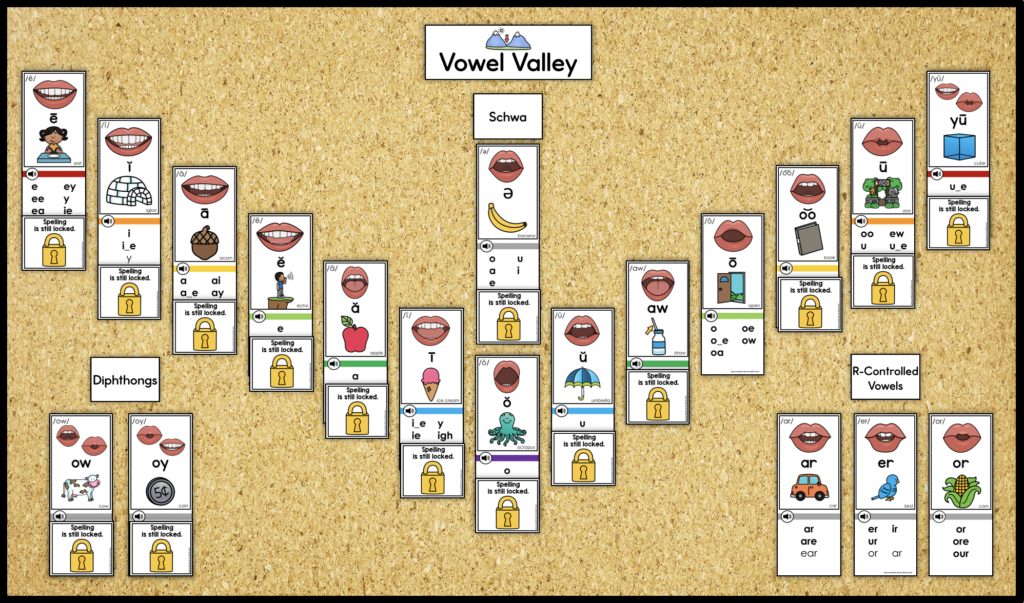
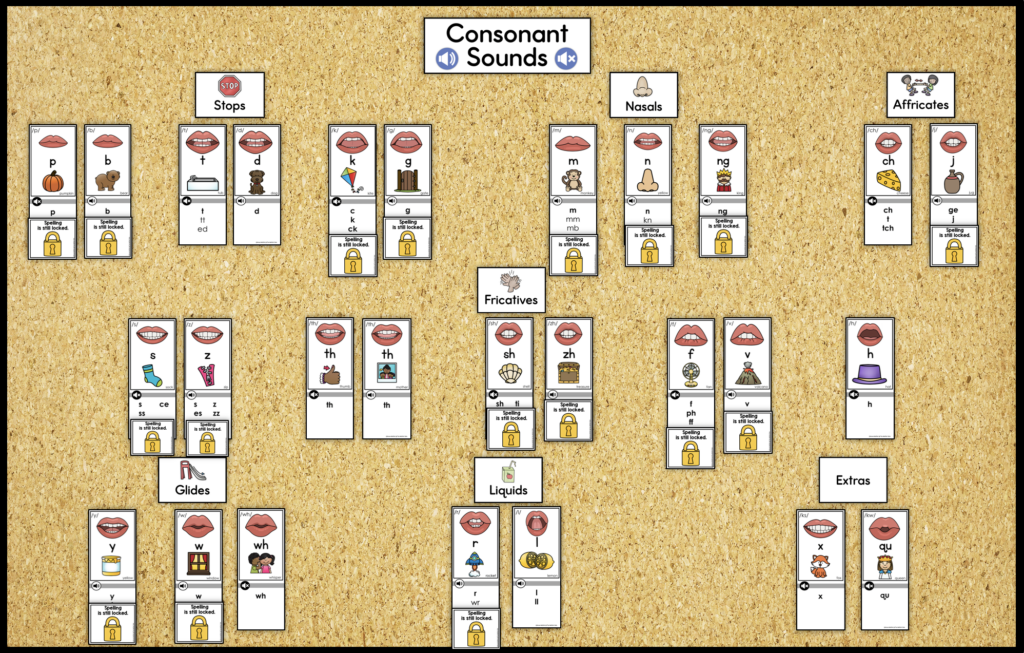
HIGH FREQUENCY WORD POSTERS
These posters show the word, letter groupings, and hearts to represent irregularly pronounced letters within the word. In addition, the cues at the bottom should be said as you introduce the irregular letter groups.

PHONICS POSTERS
These posters act as a visual aid and reminder of the phonics skills. You can use these during whole group instruction and post these so that students can refer to them as they work.



FOLDER #3: CENTER ACTIVITIES
Each week includes 4 centers for small group practice. These no-prep centers provide a hands-on way for students to take what they have learned in the whole-group instruction and practice those skills in a smaller group. This practice helps them become more fluent readers.
There are a total of four centers each week. You may want to consider dividing your class in one of two ways depending on your classroom size and schedule:
- Five groups- Four groups will each be at one of the four centers. The fifth group will be meeting for small group instruction at the Teacher Table. Each group would meet with the teacher once a week.
- Four groups- Each group will be at one of the four centers. The teacher will pull one group at a time for small group instruction at the Teacher Table. This option allows for each group to meet with the teacher daily, but requires slightly larger group sizes.
Each center includes a phonics and a high frequency word activity, with additional practice pages that correspond to the activities. Also, each center activity comes with multiple versions of each for repeated practice. For consistency, the activities are the same from week to week.

WEEKS 1-3 & 5-8: INTRODUCTION TO NEW PHONICS PATTERN & PARTNER PLAY CENTER 1 INDIVIDUAL PRACTICE ACTIVITY: SAY IT, MAP IT AND GRAPH IT
Students say the word, map each sound in the word and graph the sounds in the box.

Each center has an independent practice page that students can take home to continue this skill.

CENTER 1 PARTNER GAME ACTIVITY: SPIN IT AND GRAPH IT
Students take turns spinning the spinner, saying the word and graphing it in the boxes on the mat.


CENTER 2 INDIVIDUAL PRACTICE ACTIVITY: MAP, GRAPH AND FIND
Students say the word, graph each sound and find the word three times.


CENTER 2 PARTNER GAME ACTIVITY: ROLL, READ AND COVER
Students take turns moving on the board, reading the words and covering the picture that matches.


CENTER 3 INDIVIDUAL PRACTICE ACTIVITY: Split, Read and Match
Students draw a line to split the word into syllables, read the word and match it to the correct picture.


CENTER 3 PARTNER GAME ACTIVITY: Reader’s Theater
Partners take turns reading the decodable lines to act out the play.


CENTER 4 INDIVIDUAL PRACTICE ACTIVITY: Graph it and Search
Students say the word, graph the word into the boxes and find the word in the word search.


CENTER 4 PARTNER GAME ACTIVITY: Roll it, Read it, Check it Off!
Students take turns rolling a die, reading a decodable sentence in the box and checking it off.


WEEKS 4 AND 9: REVIEW
CENTER 1 PARTNER GAME ACTIVITY: ROLL, READ AND COVER
Students take turns rolling a die, saying the word, finding it and covering it. The first player to cover their board wins!

CENTER 2 PARTNER GAME ACTIVITY: ROLL AND READ
Students take turns rolling a die, moving their game piece and reading the word.

CENTER 3 PARTNER GAME ACTIVITY: ROLL AND READ SENTENCES
Students take turns rolling a die, moving their piece, graphing the sounds and writing the word.

CENTER 4 PARTNER GAME ACTIVITY: READERS THEATER
Students take turns reading their lines in the short story dialog.


FOLDER #4: PATHWAY TO FLUENCY UNIT 6 TEACHER TABLE TOOLS
The teacher table is where you can differentiate your reading instruction based on your students’ individual needs. The “TTT” folder has all the resources that you will need for small-group instruction for the concepts introduced in Unit 6. These materials are organized by type, and then by week. Therefore, you can easily pull activities from previous weeks for review as needed. Use the Teacher Table Tools throughout the unit to offer scaffolding for struggling students, additional practice for on-track students and extension activities for students who are ready for more challenging work.
I’ve worked to make everything as low-prep as possible for your Teacher Table Tools. Organization couldn’t be easier! Simply place the pages into a binder and teach!

ORAL PHONOLOGICAL & PHONEMIC AWARENESS PRACTICE
To start, additional phonological and phonemic awareness activities are provided. These coincide with the whole-group lesson exercises. Use them as a warm-up at the beginning of small group instruction.


LETTER CHAINING ACTIVITY
Students can use the given letters to build a word, listen for the prompt for the letter change in the word, and read the new word.


WEEKLY WORD LISTS
Each week includes a word list of all decodable words. Students can map and encode the words.

HIGH FREQUENCY WORD ACTIVITIES
Use these to help students practice mapping and graphing heart words. Remember, heart words are irregular high frequency words, or words that contain phonics skills that do not follow the same patterns as the ones they have learned thus far. Therefore, practice is important for these words.


TEACHER TABLE PHONICS ACTIVITIES:
In Pathway to Fluency Unit 6, the Teacher Table Tools file includes unique activities for students to practice the different skills for each week.
Week 1: Adding -s or -es?
In week 1, the phonics skill is adding -es to a word. During the whole group lesson, students learn about the rules for adding -es rather than just -s. This is a great follow-up activity to help students practice this skill more.


Week 2: What Sound Does -ed Make?
Students learn about inflectional endings of -ing and -ed in week 2. This activity helps students identify the 3 sounds that -ed makes, and this will help them to understand that they each have the same spelling when they hear it at the end of a word.

Week 3: Circle the Vowel That Makes a Schwa Sound
In week 3, students are introduced to the schwa sound on the sound wall. In this activity, students read the word and identify which vowel in the word makes the schwa sound.

Week 5: Is the Syllable Open or Closed?
Students are introduced to syllable types in week 5. In this activity, students look at the underlined syllable and decide if it is open or closed.

Week 6: Doubling the Consonant in a c+le Word
During the lessons in week 6, students learn about when to double the consonant in a consonant + le word.

Week 7: What Sound Does y Make?
In the week 7 lessons, students learn about the sounds that y makes. In this activity, students say the word and decide if it makes a long i sound or a long e sound.

Week 8: Filling in the Missing Silent Letter
In this activity for week 8, students say the word and write the missing silent letter on the line.

READ AND LABEL MATS
Next up, use these cards to have students decode and choose the word that matches the picture.

ENCODING MATS
Next up, use these cards to have students decode and choose the word that matches the picture.

MAP IT & MAP IT AND WRITE IT MAT
Next up, use this mat to help students map the sounds and write the word on the lines.

READING COMPREHENSION CHECK
Next up, use these cards to have students decode and choose the word that matches the picture.

COMPLETE THE SENTENCE
Next up, use these cards to have students decode and choose the word that matches the picture.

WORD FLUENCY GRIDS
Next up, use these cards to have students decode and choose the word that matches the picture.


SENTENCE FLUENCY GRIDS
Next up, use these cards to have students decode and choose the word that matches the picture.


READ AND SEEK PASSAGES
These are one of my favorite activities in Pathway to Fluency. They are decodable passages for students of all levels, and they include prompts for scaffolds, on-target and extension questions.

DECODABLE READERS
This is one of my favorite parts of this unit! Weeks 1-3 and 5-8 each have two 8-page books (three pages printed front and back) to re-enforce the phonics skills and high frequency words learned for each. Weeks 4 and 9 have three 8-page books for review. Furthermore, they build confidence in reading by allowing students to read decodable text in a fun short story.

Here’s a peek at the first book in week 1:






PATHWAY TO FLUENCY UNIT 6: MY HANDWRITING BOOK
This book offers students an opportunity to practice proper letter formation while also practicing phonics skills. You can choose to use these books at the Teacher Table to monitor mastery or as extra practice for students who have finished the center work. Each week includes 4 pages that progress to provide spiral review throughout the weeks.






I hope you find Pathway to Fluency Unit 6 helpful. Please reach out to me if you have any questions about Level 2 or about any other resources from my store.
#Pathway #Fluency #Unit






More Stories
Free K-2 Bundle! – Learning in Wonderland
SJT: God’s Love
Wednesday Wanderings: Last Day of January